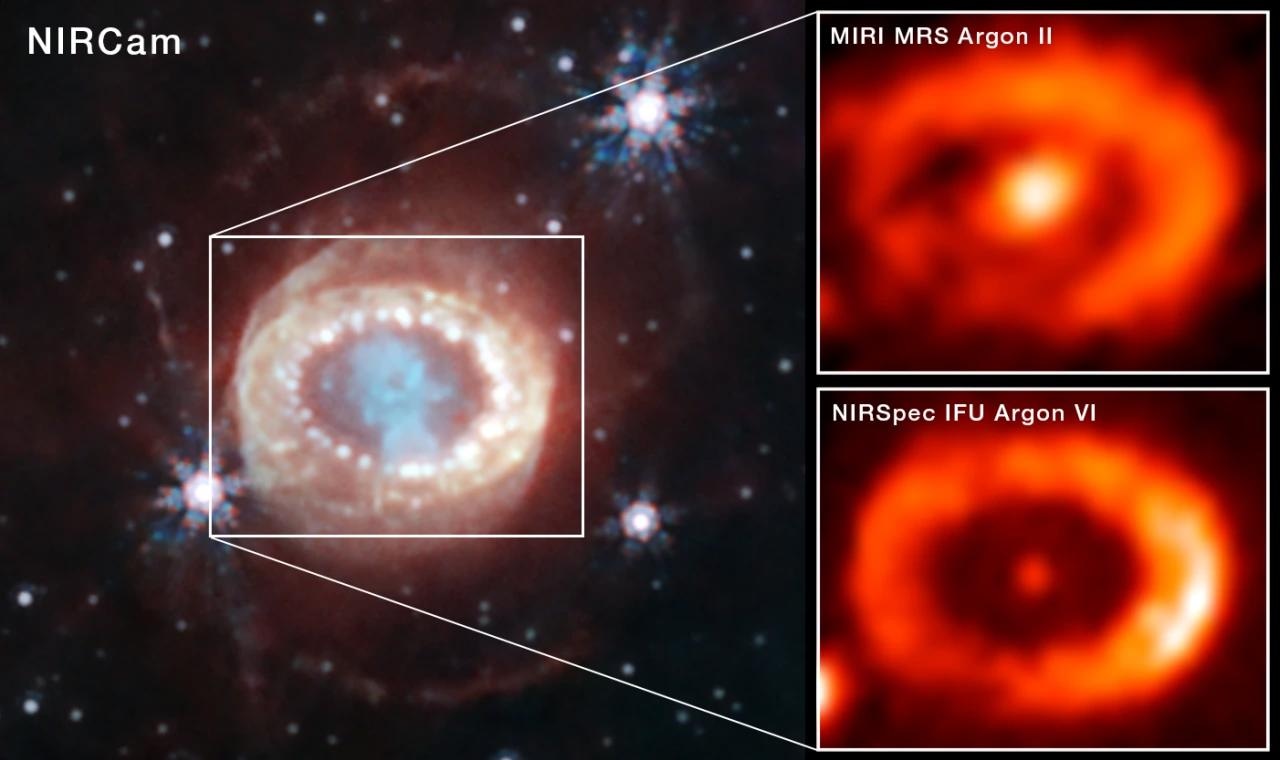Reviewed by Lexie CornerFeb 23 2024
The strongest proof of neutron star emission at the location of a recently detected supernova has been discovered by NASA's James Webb Space Telescope.
 The James Webb Space Telescope has observed the best evidence yet for emission from a neutron star. Image Credit: NASA, ESA, CSA, STScI, C. Fransson (Stockholm University), M. Matsuura (Cardiff University), M. J. Barlow (University College London), P. J. Kavanagh (Maynooth University), J. Larsson (KTH Royal Institute of Technology)
The James Webb Space Telescope has observed the best evidence yet for emission from a neutron star. Image Credit: NASA, ESA, CSA, STScI, C. Fransson (Stockholm University), M. Matsuura (Cardiff University), M. J. Barlow (University College London), P. J. Kavanagh (Maynooth University), J. Larsson (KTH Royal Institute of Technology)
The supernova, designated as SN 1987A, was a core-collapse supernova, which means that a black hole or a neutron star was created by the compacted remnants at its core. While indirect evidence for the presence of a neutron star has previously been discovered, this is the first time that the effects of high-energy emission from the likely young neutron star have been detected. Evidence for such a compact object has long been sought after.
Supernovae, the violent last gasps of some very large stars, explode in a matter of hours and reach their maximum brightness in a matter of months. Over the ensuing decades, the remnants of the exploding star will continue to change quickly, providing astronomers with a unique chance to observe a crucial astronomical process in real-time.
Supernova 1987A
In the Large Magellanic Cloud, 160,000 light-years from Earth, the supernova SN 1987A occurred. It was first seen on Earth in February 1987, and in May of the same year, it reached its maximum brightness. Since Kepler's Supernova was discovered in 1604, this was the first supernova that could be seen with the unaided eye.
Three observatories worldwide detected a brief burst of neutrinos about two hours before the first visible-light observation of SN 1987A. The two distinct kinds of observations were connected to the same supernova explosion and offered crucial information that shaped the understanding of the mechanism underlying core-collapse supernovae. This theory included the prediction that a black hole or neutron star would form from this kind of supernova. Since then, astronomers have looked for proof that one or more of these compact objects exist at the center of the expanding remnant material.
Recent years have yielded indirect evidence for the existence of a neutron star at the remnant's center, and observations of much older supernova remnants, like the Crab Nebula, have confirmed the presence of neutron stars in various supernova remnants. However, up until now, no concrete proof of a neutron star following SN 1987A—or any other recent supernova explosion—had been found.
From theoretical models of SN 1987A, the 10-second burst of neutrinos observed just before the supernova implied that a neutron star or black hole was formed in the explosion. But we have not observed any compelling signature of such a newborn object from any supernova explosion. With this observatory, we have now found direct evidence for emission triggered by the newborn compact object, most likely a neutron star.
Claes Fransson, Study Lead Author, Stockholm University
Webb’s Observations of SN 1987A
The SN 1987A remnant was one of the first objects Webb observed when it started science observations in July 2022. The Webb observations that supported this work were taken on July 16. The group employed Webb’s MIRI (Mid-Infrared Instrument) in its Medium Resolution Spectrograph (MRS) mode, which was developed with assistance from other team members. An Integral Field Unit (IFU) is a type of instrument that includes the MRS.
IFUs can image and capture a spectrum of an object simultaneously. Every pixel on an IFU creates a spectrum that viewers can view to see spectroscopic variations throughout the object. The velocity at each position can also be evaluated by analyzing the Doppler shift of each spectrum.
Spectral analysis of the data revealed a significant signal from ionized argon from the center of the material that was ejected and surrounded SN 1987A's original location. Even more strongly ionized chemical elements were discovered by subsequent observations made at shorter wavelengths with Webb’s NIRSpec (Near-Infrared Spectrograph) IFU. Notably, five times ionized argon (argon atoms with five of their eighteen electrons) was discovered. For such ions to form, extremely energetic photons must originate from some source.
To create these ions that we observed in the ejecta, it was clear that there had to be a source of high-energy radiation in the center of the SN 1987A remnant. In the paper, we discuss different possibilities, finding that only a few scenarios are likely, and all of these involve a newly born neutron star.
Claes Fransson, Study Lead Author, Stockholm University
This year, additional Webb and ground-based telescope observations are planned. The research team's continued investigation aims to shed more light on the precise processes taking place in the center of the SN 1987A remnant. Ultimately, these observations should encourage the creation of more intricate models, which will help astronomers gain a deeper understanding of not only SN 1987A but all core-collapse supernovae.
These findings were published in the journal Science.